
WasteCare Corporation is your source for commercial trash compactors, balers, waste equipment, recycling equipment, industrial shredders and grinders, and other waste related products and services.
Home > Sitemap > Compactors >
UNIVERSAL FLUORESCENT BULB & LAMP
CRUSHER
Handles all types of bulbs such as CFL's,
Straight, U-Shaped & HID's (up to 6")
REDUCE BULB & LAMP
DISPOSAL COSTS BY UP TO 50%; STORAGE SPACE BY 80%; AND
FOR EVERY 50 BULBS
PROCESSED SAVE ABOUT 1 MAN HOUR SPENT ON BOXING VERSUS CRUSHING
All-in-One Bulb Crusher
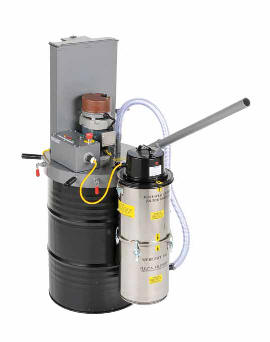
Universal Bulb Crusher
There are 9 states in which these types of Bulb Crushers are not allowed: (It has nothing to do with the Bulb Crushers but rather these States have just not approved this type of Bulb Crushing).
CA, CT, MO, MN, NH, PA, RI, VT, WV
Request Automated Response with general pricing
Request
Info On Multiple Products - (Secure Area)
For other types of Bulb Crushers Click Here
Request Info On Multiple Products - (Secure Area)
This is an All-in-One Bulb Crusher that does CFL's, Straight Fluorescents, U-Shaped Fluorescents and HID's (up to 6"), or basically all types of fluorescent bulbs including mercury vapor and high pressure sodium. There are many user-friendly features incorporated in the machine to help not only with convenience but also low maintenance, time savings, longevity and long term cost savings. This includes the Easy Change Drum System, Drum Level Indicator, Filter Indicator, Open Top Indicator, Innovative Safety Features and many other proven criteria that allow for care-free operation and quick paybacks. The machine meets OSHA, NIOSH, ACGIH and European Clean Air Standards. In addition to all the many user-friendly features it is built with an industrial grade design consisting of Five Stage Filtering, 8 - 10 gauge steel, tempered steel blades, stainless steel construction, heavy duty AC Motor, Two Year Warranty and more.
Note: States where the services for getting pick-ups / hauling of the Crushed Bulbs is easiest is below:
AL, AR, AZ, CO, DC, FL. GA, IA, IL, IN, KY. LA, MA, MD, MS, NJ, NY, OH, TN, TX, VA
The areas / States that may be the most difficult are Pacific NW (excluding Metro Seattle); the Rockies (exclusing metro Denver); the Dakotas, and the plains (excluding urban areas in KS and OK
Read about Recycling Fluorescent Bulbs
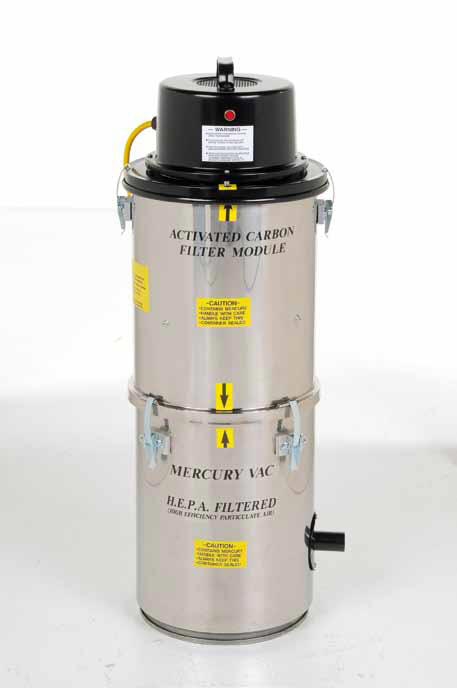 |
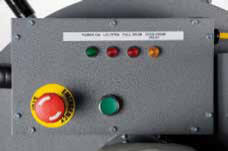 |
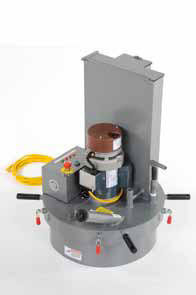 |
| HEPA Filter, Carbon Filter & Vacuum | Control Panel | Lid Assembly |
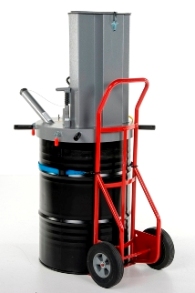
Drum Dolly
UNIVERSAL BULB CRUSHER - BASIC SPECIFICATIONS
UNIVERAL BULB CRUSHER Model
UBC-1800 - Does
CFLs, Straight & U-Shaped Fluorescent
Bulbs and HID's (up to 6")
|
||
| Feed Rate | As fast as can be manually fed | |
| Electrical / Motor: | Main: 1/ 3 HP Heavy Duty AC Motor 120v | |
| Weight | 290 Pounds (with Optional Drum - 350 lbs) | |
| Height: | 90" with the Chute / tube & 66" without. (Overhead clearance below 8'). | |
| 5 Stage Filtration | ||
| Stage 1 | Industrial Grade Disposable Bag Filter (Replace every 2 Drums) | Collects Dry Contaminated particulate and contaminated debris |
| Stage 2 | Dacron Bag | Covers and Protects the HEPA Filter Module |
| Stage 3 | Pre-Filter (Replace every 2 drums) | Insures smooth air flow through the HEPA Filter |
| Stage 4 | H.E.PA. Filter (Replace every 10 drums) | Removes 99.97% of all particulate up to 0.3 microns from air stream |
| Stage 5 | Activated Carbon Filter (Lifetime capacity - calculated rating of 1 million Bulbs / Lamps) | Traps the Mercury Vapor - (Designed to be Disposable) |
| Stage 6 | Optional | |
| Vacuum (Final Stage of Filter Module which creates a vacuum within the system) | Red light indicator tells when filter needs replacing or a blockage | |
| Exposure in Operator's Breathing Zone | Meets OSHA standard of 0.1 mg/m3 | |
| Meets OSHA, NIOSH, ACGIH and European Clean Air Standards | ||
| Crushed Lamp Capacity | ||
| 3,000 | CFL'S / Compact Fluorescent Bulbs / Lamps (per drum) | |
| 1100 | 4' T8 Straight Bulbs / Lamps (1.0" diameter) per drum | |
| 700 | 4' T12 Straight Bulbs / Lamps (1.5" diameter) per drum | |
| 250 | 4' T17 Straight Bulbs / Lamps (2.0" diameter) per drum | |
| 400 | 4' T12 U-tube Bulbs / Lamps (1.5" diameter) per drum | |
| 350 | 8' T12 Straight Bulbs / Lamps (1.5" diameter) per drum | |
| Includes: All Entry tube accessories for bulb types indicated plus 10 Drum Filter Pack | ||
| Electrical: Choice of either 110v (Standard) or Optional 220v (Adds cost of transformer) | ||
| Recommended Accessories: Extra Filter Pack | ||
Universal Bulb Crusher - Additional Features
- Exceeds emission standards set by OSHA , NIOSH, ACGIH and European Clean Air Standards..
- Processes a large variety of Bulbs and Lamps (Fluorescent, CFL's, HID's) including mercury vapor and high pressure sodium lamps.
- Easy Change Drum System. (Drums are sold separately)
- Stainless Steel Construction
- Industrial Grade components including 8 - 10 gauge steel construction
- Crushers come with 10 Drum Filter Kit (Lasts for 10 full Drums approximately)
- Heavy duty 1/3 HP motor 120v.a.c..
- At all critical Filtration Points, machine is under total negative pressure
- Handles bulbs and lamps of all lengths (up to
12') and diameters up to 6"
Designed for low maintenance & extended life including super large capacity filter bag, HEPA Filter and charcoal module - Charcoal canister is rated at between 3 and 4 million bulbs.
- Open Top Indicator
- Drum Level Indicator
- Filter Saturation Indicator
- Tempered Steel blade for crushing all types of bulbs and lamps
- Designed for use in areas with low ceiling heights (such as ships and other such applications where operating height is an issue)
- Numerous Safety Features for protecting against operator access to moving parts and/or accidental start-up of machine.
- 2 year warranty
Benefits of Bulb Crushers
- One of the biggest benefits of bulb Crushers is that they greatly reduce the handling of spent bulbs / lamps. Bulb Crushers are very portable
and can be easily moved to a staging area where the spent bulbs can be processed through the machine. Streamlining waste routines can oftentimes depend on equipment that serves as a driving force for achieving efficiency.
- Significant labor savings can be realized through the use of Bulb Crushers versus the traditional way of boxing the Fluorescent bulbs / lamps. (It is estimated that roughly 1 man hour per 50 bulbs can be saved by crushing rather than boxing the bulbs! )
- Bulb Crushers can help to eliminate storage issues which invariably lead to breakage. The equivalent of approximately 1000 bulbs can be accumulated in a 55 gallon drum before needing to be emptied.
- Since the EPA estimates that the accidental breakage rate is 2% - 3% while storing and boxing bulbs, this means that Bulb Crushers can greatly reduce exposure to employees which ultimately means a safer work environment and less risk of claims and fines. (And, the 2% - 3% rate is believed by many experts to be greatly underestimated based on industry knowledge).
- By pre-crushing the bulbs, facilities are able to save money on
bulb recycling costs. Savings are typically anywhere from a dime to $1 per lamp!
General Information about Bulbs / Lamps
Mercury is a persistent, bio-accumulative toxin that has increased at least three fold in the atmosphere and ocean over the past century, posing a risk to human health, wildlife and the ecological balance. A potent neurotoxin, it is highly toxic to the human nervous system and particularly poisonous to the kidneys, brain, and liver, and can cause developmental problems. Mercury is a metallic element that can accumulate in living tissue. In sufficient concentrations, mercury may cause adverse health effects. Sources of mercury in the environment from human activity include fluorescent and HID lamps as well asoal-burning power plants, batteries .
A fluorescent lamp consists of a glass shell, a high vacuum, a small amount of liquid mercury and evaporated mercury, some phosphor powder, and the metal end caps and heated filaments.
Fluorescent light is produced by passing an electric current through mercury vapor, which generates ultraviolet energy. A phosphor coating on the inside of the bulb transforms the ultraviolet energy into visible light. A single four-foot fluorescent tube contains from 5 to 50 milligrams of mercury.
When Bulbs / lamps are sent to landfills (or especially when incineration is used as an alternative disposal method) mercury vapors are released that can travel over 200 miles! Once absorbed by the body, mercury is distributed by the blood to all tissues of the human body, and it easily crosses the placental barrier; prenatal exposure can lead to a variety of health problems including a severe form of cerebral palsy.
- Each year, an estimated 600 million fluorescent lamps are disposed of in the US landfills amounting to 30,000 pounds of mercury waste.
- The Environmental Protection Agency reports that 187 incinerators nationwide emit approximately 70,000 total pounds of mercury into the environment each year.
- In 1992, mercury-containing lamps were added to the United States' Environmental Protection Agency's (EPA) list of hazardous substances. (The EPA's regulatory threshold of 0.2 mg./liter is usually exceeded by mercury-containing lamps).
- Mercury was number three on the 1997 list of hazardous substances as outlined by the Agency for Toxic Substances and Disease Registry (ATSDR) and the EPA.
Due to the new Federal Environmental Protection Agency's regulations on lamps, which went into effect on January 6th, 2000, most non-residential facilities are now required by law to properly dispose of their lamps. Landfills are increasingly intolerant of lamps from non-residential sources due to the amount of mercury found in each lamp. Lamps later found in landfills are subject to retroactive clean-up costs under CERCLA. Recycling of the lamp components is the recommended method of disposal by the Environmental Protection Agency and helps to minimize facility liability.
Bulb Crusher - FAQ's
Listed below are some of the more common questions we are asked regarding the system.
How does the Universal Bulb Crusher work?
- The bulb is fed into the entry tube of the machine.
- Instantly it is crushed to pieces by the tempered steel blade.
- The Bulb Crusher’s filtration system pulls the contaminated air out of the drum to filter out the released powder as well the mercury vapor.
- The contaminated air goes through a 5 stage Filtration process.
- At that point the air is clean but still contains mercury vapor.
- The mercury vapor is then processed.
- The carbon filter not only captures the mercury vapor, but also neutralizes it by converting the vapor to mercuric sulfide, which is non-hazardous.
- Clean air comes out of the Fluorescent Lamp Crusher / Compactor exhaust vent.
How long does it take for the Universal Bulb Crusher to crush the bulbs?
The Bulb Crusher will crush bulbs as fast as it can manually be fed.
Is it safe?
It is very safe. Studies show that it is actually safer to package bulbs by using Bulb Crushing Systems than boxing the bulbs. This is because the Bulb Crushers capture over 99.99% of the mercury vapor released during crushing. While there is a small amount of mercury vapor released, the overall mercury exposure is significantly less than when managing the same quantity of bulbs by traditional means (where there is always going to be accidental breakage). Regardless of how careful employees are, breakage is going to occur.
What do we do with the Crushed Bulbs?
Once you have the bulb crusher you will be in a position to handle this process on your own fairly easily however we will also help you through the process. Depending on your state regulations, you may be able to exclude this waste from your hazardous waste totals. We can also help you locate a Recycling Facility however there are Recycling facilities all across the country (and worldwide as well) that handle the processing of the crushed bulbs.
How often do the filters need to be changed?
The filters need to be replaced on a scheduled basis. Typically the Filter Packs are purchased as a set that last for 10 Drums. (Referred to as a 10 Drum Filter Pack). When changed, the filters can be placed on top of the crushed glass inside the drum (depending on applicable regulations). The filters are sent for recycling with the crushed lamps in the drum. The activated carbon filter is rated for over a million bulbs which means most customers will never have to change this filter. All filters are designed to be disposable. .
What is the warranty?
The Warranty is 2 Years with the Standard exclusions of abuse, misuse and so forth. (The warranty does not cover damage resulting from negligent handling, misuse or lack of reasonable care).
Regulatory FAQ's
Listed below are some of the more common regulatory questions.
Understanding whether your waste is hazardous?
All generators of waste, except households, are responsible for determining if their waste is hazardous under current state and federal regulations. Hazardous wastes can either be included on specific lists or exhibit hazardous characteristics. This determination can be done by knowledge of the waste or by testing the waste. The Toxicity Characteristic Leaching Procedure (TCLP) is the test used to determine if a waste exhibits a toxicity characteristic. Wastes found to be hazardous are subject to the hazardous waste management regulations.
What’s is considered Hazardous?
In most cases, standard fluorescent bulbs and lamp fragments fail the TCLP test and are considered hazardous wastes. Facilities should treat the spent lamps and lamp fragments as hazardous wastes unless they test the spent lamps and fragments and determine that the wastes are non-hazardous. Facilities should manage the spent lamps as hazardous waste according to applicable federal, state, and local requirements. Throwing spent lamps in the trash can be very costly since it could result in a facilities or company being held responsible for the cleanup of a remote Superfund site so the potential liability is huge.
What are Universal Wastes?
Universal wastes are specific hazardous waste streams that facilities can choose to manage in an alternative manner in place of the more complex hazardous waste requirements. These wastes are typically generated by many facilities and are often not properly managed under hazardous waste regulations.
Universal Wastes include:
Lamps / Bulbs – Including fluorescent, high intensity discharge (HID), sodium vapor, mercury vapor, neon, and incandescent lamps Batteries – Including spent dry cell and lead-acid batteries Pesticides – Including certain suspended, canceled, or unused pesticides Devices containing elemental mercury – Including thermostats, switches, thermometers, manometers, barometers, and various medical devices
Does the Volume of Hazardous Waste Matter?
RCRA (hazardous waste) requirements do differ according to the amounts of hazardous waste generated per month by a facility. The 3 main categories of hazardous waste generators are outlined below:
Conditionally Exempt Small Quantity Generators (CESQG's) are persons who generate 220 lbs. or less of all hazardous wastes combined (not just l areamps!). These generators are exempt from most of the hazardous waste regulations, which include transportation, treatment, and disposal requirements. They must not, however, store more than 2200 lbs. of hazardous waste on site at any time and must dispose of their hazardous waste in facilities that are permitted or authorized to accept hazardous or non-hazardous wastes. Many states acknowledge CESQG exemptions for paperwork, but not for disposal. Many states do not allow CESQG to dispose of hazardous waste in a solid waste landfill.
Small Quantity Generators (SQG) are persons who generate 220 to 2200 lbs. of hazardous waste per month. These generators must keep proper records of the waste, report to EPA, and follow accumulation requirements. These generators can store up to 6 months without a storage permit.
Large Quantity Generators (LQG) generate more than 2200 lbs. of hazardous waste per month. These generators are subject to the full hazardous waste management requirements. These generators cannot store hazardous wastes on site for more than 90 days (3 months) without obtaining a storage permit.
There are 2 categories of Universal Waste handlers:
- Small Quantity Handler - Generator who accumulates less than 11,000 lbs. of universal waste (batteries, pesticides, thermostats, or lamps) at any time.
- Large Quantity Handler - Generator who accumulates more than 11,000 lbs. of universal waste (batteries, pesticides, thermostats, or lamps) at any time.
Universal Waste Storage Limits:
- Both Small and Large Quantity Generators of Universal Waste can generally store their Universal Waste for one year. (For more information please contact your state Environmental Protection Agency.)
How is controlled crushing regulated?
Controlled crushing of bulbs is regulated under both federal and state hazardous and universal waste regulations. The federal universal waste regulations do not authorize on-site crushing of fluorescent bulbs but do allow the States to write rules that will permit crushing on-site. Most states allow the crushing of bulbs on-site under the universal waste regulations. (Some states do not have a universal waste category but do have a "Characteristic By-Products" classification which is very similar to a universal waste classification.) There are still a few states that prohibit Bulb Crushers in general (having nothing to do with the specific products we offer). Currently those states are California, Vermont, Minnesota, Missouri, Maine, Connecticut, Pennsylvania, New Hampshire, Rhode Island and West Virginia. New Jersey allows them provided the facility obtains a special ermit.
In States that allow crushing and classify crushed bulbs as universal wastes, persons can generally store their waste lamps on-site for up to one year, can ship waste lamps off-site with a bill of lading rather than a hazardous waste manifest, and need not include their lamps when calculating their hazardous waste totals.
Under state and federal hazardous waste regulations, controlled crushing (which is what the Fluorescent Lamp or Bulb Crusher / Compactor systems do) is considered treatment. The hazardous waste rules typically require a person who treats wastes to obtain a permit. Federal and most state hazardous waste rules, however, exempt from the permit requirement persons who treat their wastes "within a drum, tank, or container." (See 40 CFR 262.34). Many States have acknowledged in letters that the accumulation tank exemption applies to the Fluorescent Lamp Crusher / Compactor systems (and of course we also feel that the Fluorescent Lamp Crusher / Compactor systems clearly fall within this exemption.)
If your State does not allow crushing under its universal waste regulations, then you typically may manage crushing under your state's hazardous waste regulations as a process exempt from the general permitting requirements. Please note that regardless of whether the bulbs are managed as universal or hazardous wastes, you must properly dispose of the crushed lamps preferably by shipping the crushed lamps to a permitted recycling facility.
How do I get more information on these regulations?
Customers are always welcome to contact us for further information concerning federal and state regulations. We have a list of contact names at both federal and state environmental protection agencies, as well as guidance papers from many states that are available to our customers. We are more than willing to help you learn more about applicable regulations.
Note: Specifications, Dimensions & other product details may vary slightly upon delivery due to continuous product progressions and improvement. If exactness is required on any item(s), confirm in writing before ordering. In our efforts to provide products with the most up to date engineering and design, we reserve the right to change specifications, dimensions and other product details without notice.
Performance may vary depending upon application.
Products must be installed and operated according to required standards, codes, regulations and safety procedures.
 Printer Friendly / Create PDF
Printer Friendly / Create PDF

